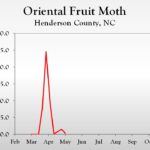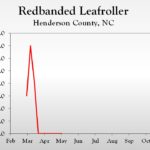WNC Orchard Insect Pest Populations – May 12, 2020
go.ncsu.edu/readext?690570
en Español / em Português
El inglés es el idioma de control de esta página. En la medida en que haya algún conflicto entre la traducción al inglés y la traducción, el inglés prevalece.
Al hacer clic en el enlace de traducción se activa un servicio de traducción gratuito para convertir la página al español. Al igual que con cualquier traducción por Internet, la conversión no es sensible al contexto y puede que no traduzca el texto en su significado original. NC State Extension no garantiza la exactitud del texto traducido. Por favor, tenga en cuenta que algunas aplicaciones y/o servicios pueden no funcionar como se espera cuando se traducen.
Português
Inglês é o idioma de controle desta página. Na medida que haja algum conflito entre o texto original em Inglês e a tradução, o Inglês prevalece.
Ao clicar no link de tradução, um serviço gratuito de tradução será ativado para converter a página para o Português. Como em qualquer tradução pela internet, a conversão não é sensivel ao contexto e pode não ocorrer a tradução para o significado orginal. O serviço de Extensão da Carolina do Norte (NC State Extension) não garante a exatidão do texto traduzido. Por favor, observe que algumas funções ou serviços podem não funcionar como esperado após a tradução.
English
English is the controlling language of this page. To the extent there is any conflict between the English text and the translation, English controls.
Clicking on the translation link activates a free translation service to convert the page to Spanish. As with any Internet translation, the conversion is not context-sensitive and may not translate the text to its original meaning. NC State Extension does not guarantee the accuracy of the translated text. Please note that some applications and/or services may not function as expected when translated.
Collapse ▲ Expect Codling Moth Activity to Pick Up with Return of Warmer Temperatures
Expect Codling Moth Activity to Pick Up with Return of Warmer Temperatures
The cool temperatures during the past week suppressed insect activity, as evidenced by the very low pheromone trap captures. However, activity will pick up later in the week with the return of warmer temperatures. The codling moth degree-day (DD) model predicts initial egg hatch to occur at about 250 DD after biofix, which is also the recommended timing of an initial insecticide application in orchards with moderate to high codling moth populations. In orchards with low populations, an application can be delayed until 350 DD. In Henderson County, 250 DD is not expected to occur until May 18. Off the mountain at lower elevations considerably more DD have accumulated. In the Lincoln and Cleveland County areas DD accumulations have reached about 400 DD, which is equivalent to about 10% egg hatch. In these areas, protection of the crops will be important later this week and into next week.
Time to Target San Jose Scale Crawlers
For those concerned about San Jose scale and wanting to target first-generation crawlers, an insecticide application within the next two weeks should be considered. See last week’s update for more information.
Brown Marmorated Stink Bug
I have received several questions about the status of brown marmorated stink bug (BMSB), and in view of the current emergence of overwintering adults, now may be a good time to review its life cycle and potential for damage.
Overwintering Adult Emergence and Egg Laying: The vast majority of overwintering BMSB adults emerge during April and May. While we are slightly behind the curve this year due to relatively cool temperatures, the return of warmer weather should put us on track to be completed by late May or early June. Overwintering adults reside largely in wooded habitats, feeding and laying eggs on wild hosts from mid-May through July. Egg laying can begin as early as mid-May in lower elevations (piedmont) to late May in mountain apple production regions (>2000 ft); peak oviposition occurs during the month of June. These wooded habitats are also where the vast majority of nymphal populations reside and complete development.
While occasionally a few adults may be found in apple orchards during June, apples are not a highly attractive host during this time. Slightly more attractive hosts are peaches and pears, where BMSB can be more easily found in June. In previous years, high pheromone trap captures of the overwintering generation have occurred in late May.
First Generation Adults: When first-generation nymphs in wooded areas develop to the adult stage, many of these adults disperse to crops, with a high preference for those plants bearing fruiting structures, including apples and many other crops (peaches, pears, corn, soybeans, etc.). It is this first generation of adults that present the greatest threat to apples. The timing of first-generation adults varies from July in the piedmont to August in the mountains.
Predicting Adult Emergence: We have recently completed a degree-day (DD) model that can be used to predict emergence of first-generation adults. The model functions similar to that of the codling moth DD model. April 1 is used as biofix (date to begin accumulating DD) and lower and upper developmental threshold temperatures of 14.2°C and 35.6°C, respectively, are used to calculate DD. First-generation adults begin to emerge at about 700 DD (°C), with 10% of adult emergence complete by 750 DD; the range of DD during for emergence of 10-90% emergence occurs is 740-1245 DD (°C). In 2019, 700 DD occurred on 3 July in Cleveland County and 31 July in Henderson County. Further east in Wayne County in the coastal plain region, 700 DD occurred on 8 June. The equivalent of 700 cumulative DD (°C) in Fahrenheit is 1400 DD (°F)
Pheromone Trap Threshold: While we can now predict when first-generation adults emerge, it should be recognized that not all locations have damaging populations of BMSB. Last year we conducted studies to assess a threshold of a cumulative capture of 4 BMSB adults per trap as a trigger for insecticide applications – weekly trap captures were added for each successive week. This threshold was deemed too low as it resulted in over spraying. These studies will be continued this year to try and narrow down an appropriate threshold level.
In the next few weeks we will begin reporting on BMSB DD accumulations and pheromone trap captures in the region.
Learn more about southeastern apple insect pests at the Apple Insect Management page.
2020 Average Weekly Trap Captures
| HENDERSON COUNTY | |||
| Insects per trap | |||
| Apr 27 | May 4 | May 12 | |
| Codling moth | 0.4 | 1.6 | 0.4 |
| Oriental fruit moth | 0.8 | 1.5 | 0.3 |
| Tufted apple bud moth | 1.0 | 14.0 | 11.0 |
| Redbanded leafroller | 0.0 | – | 0.0 |
| Obliquebanded leafroller | 0.0 | 0.0 | 0.0 |
| Lesser appleworm | 0.0 | 0.0 | 0.0 |
| Apple maggot (abandoned and research orchards) | – | – | – |
| Brown marmorated stink bug (commercial) | 0.0 | 0.8 | 0.3 |
| Brown marmorated stink bug (unsprayed) | 0.0 | 0.3 | 0.1 |
| Spotted tentiform leafminer | 0.0 | 0.0 | 0.0 |
| Dogwood borer | set | 0.0 | 1.0 |
| Peachtree borer | 0.0 | 0.0 | 0.0 |
| Lesser peachtree borer | 0.0 | 51.0 | 20.0 |
| San Jose scale | 0.0 | 0.0 | 0.0 |
*Note that these averages illustrate only the timing of insect emergence and fluctuations in populations, and are not representative of population levels in any given orchard. The only way to have an accurate assessment of an individual orchard’s populations is to set up traps in that orchard.
2020 Accumulated Degree Days
| HENDERSON COUNTY | ||||
| Apr 27 | May 4 | May 12 | ||
| Codling moth (Biofix 4/20) | 34 DD | 90 DD | 135 DD | |
| Oriental fruit moth (Biofix 3/30) | 250 DD | 332 DD | 400 DD | |
| Tufted apple bud moth (Biofix 4/27) | Biofix | 74 DD | 142 DD | |
2020 Pest Trends (click to enlarge)
Visit WNC Orchard Insect Populations for archived posts.






